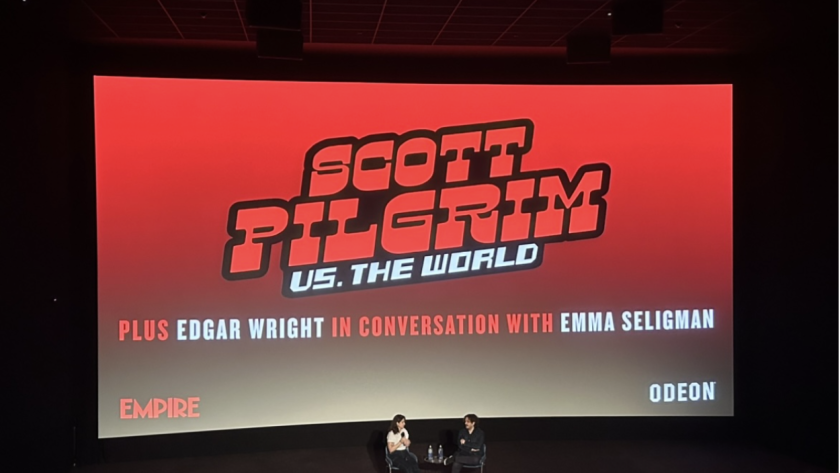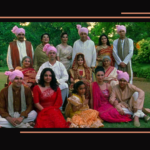Mayra Nassef attends the Scott Pilgrim screening alongside an ‘in conversation with Edgar Wright and Emma Seligman.
Scott Pilgrim vs the World has become a belated cult classic 13 years after it first released on the big screen. Perhaps nothing reflects this more than the Odeon West End selling out their tickets for the screening of the film on the same day they were released. This wasn’t just a normal screening of the film though: it included a Q&A and Intro by both Edgar Wright (director of Scott Pilgrim vs the World) and Emma Seligman (director of Bottoms and Shiva Baby) with Emma Seligman becoming a breakout filmmaker as of late, and Edgar Wright being cited as a major influence on her work by her.
The inception of the film as Wright describes it is quite fitting to the content and atmosphere of the film. Brian Lee O’ Malley – the creator of the Scott Pilgrim books – “handed” the first book to Wright, and described the atmosphere and tone of the work as a mix between “John Hughes and Kill Bill”. The fact that there was not a lot of source material to go off of at the time meant that Wright had the space to really try everything. It is in this way that there is that signature Wright style that all film buffs have grown to know and love, but it has also allowed for an interesting tonal consistency within Wright’s career in itself. O’ Malley was highly involved in the process of making the film. For example, his handwriting can be seen in all the handwritten notes in the film, including but not limited to Ramona Flowers’ number on Wallace’s fridge.
Wright describes sending and receiving playlists from O’Malley as the Scott Pilgrim books would come out. While this heavily inspired the film, the music in the film also deeply incorporates real-life bands, and especially the Toronto/Canada music scene. Wright remarks on how the opening Sex-Bob-Omb song was actually the first take from Beck’s recording for the film. That did add an element of authenticity to the film, as actors also had to learn the songs with the mistakes that were inevitable because of the recordings’ natural rough edges. Inextricably linked with the manga, the film also uses Toronto-based music acts such as Metric for the soundtrack. The character of Envy Adams is actually partially based off of Emily Haines from the band. In addition to this,
Seligman – a Toronto native – found great joy in the fact that the film takes place in Toronto. She quips about how Canada and especially Toronto has been routinely used as a cheaper film location alternative for many filmmakers. While in those projects, Canada is usually used to represent another place like New York City, Scott Pilgrim fully embraces its Canadian identity. The world really feels well-grounded in Toronto as a city as Seligman points out that the film refers to real-life locations such as Pizza Pizza, and takes place in the good as well as the dodgy parts of town.
In the Q & A, Wright relates Scott Pilgrim vs the World to his breakout TV show Spaced in which both works heavily incorporate the concept of magical realism. He describes both works as following “ordinary characters” that are “relatable” in a particularly derelict post-school setting. One of the audience members comments on how Scott Pilgrim vs the World depicts an unlikeable person, to which Wright agrees and notes on how the film showcases Scott’s character development across the film. Perhaps influenced by this tidbit, and maybe also as a result of this fact, Wright changed the ending of the film. Originally, Scott Pilgrim was supposed to end up with Knives Chau, but then Wright realised that did not feel right. Knives Chau “deserved better” and his ending with Ramona Flowers is quite uncertain and not necessarily a “happy ending” a la Eternal Sunshine of the Spotless Mind (2004).
For Wright, Scott Pilgrim vs the World was a career milestone and shift. It was his first project outside of the UK, and also the first one in which he did not collaborate with long-time collaborators Simon Pegg/Nick Frost. In addition to that, he also had to consistently sell the idea of the film to the studio. It’s such a unique project that Wright recommended that using a notable name in the crew helped. For example, Bill Pope was on board – the cinematographer from The Matrix – which gave the studios some confidence. Despite this, he also kept his grounding by keeping his editors from his previous projects as well as his producer from Spaced.
A really unique part of the film is the fight choreography. Wright brought in Brad Allen – who recently passed away – to choreograph the fight scenes, having famously worked with Jackie Chan. Most of the actors did a lot of their own stunts which meant they also had to learn the choreography and hit the gym. Wright recalls how some of the cast who weren’t involved in any fight scenes such as Kieran Culkin would show up to the gym for the workouts because they felt “left out”. He describes the atmosphere as being quite fun and paradoxical, as Michael Cera would be working out next to Chris Evans – something that represents the film’s character quite well.
Even as most of the film was vehemently practised, it still gave room for improv. Especially with some lines such as Chris Evans’ lines as Lucas Lee and Michael Cera’s conversation with Nega Scott at the end of the film in which he describes his order from his favourite brunch place in Toronto. On the other hand, Scott Pilgrim also had scenes such as the Roxy fight scene – one of the evil exes – which took a total of 4 days to film. This duality, and the passion behind the film is really something that translates well on screen and is why the film has amassed such a cult following. Even 13 years later, the film feels refreshing and completely unique in style. Heavily using video game motifs and manga aesthetics was a deliberate choice on Wright’s behalf. Perhaps as an extension and as a result of this project, there will be an anime adaptation of Scott Pilgrim releasing on Netflix on November 17th in which almost the entire cast returns to reprise their roles as voice actors!



